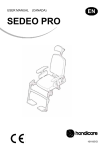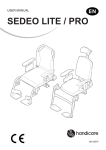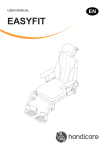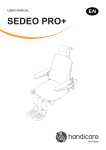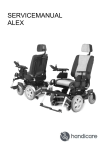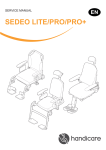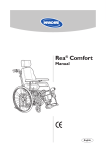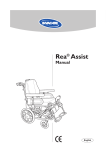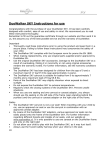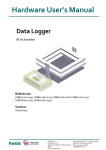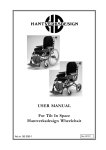Download Sedeo Pro Owner`s Manual 2012
Transcript
USER MANUAL EN SEDEO LITE / PRO 1011651D Sedeo Lite .......................................................................................4 Sedeo Pro.......................................................................................31 Sedeo Lite © 2011 Handicare All rights reserved. The information provided herein may not be reproduced and/or published in any form, by print, photoprint, microfilm or any other means whatsoever (electronically or mechanically) without the prior written authorization of Handicare. The information provided is based on general data concerning the construction known at the time of the publication of this manual. Handicare executes a policy of continuous improvement and reserves the right to changes and modifications. The information provided is valid for the product in its standard version. Handicare can therefore not be held liable for any damage resulting from specifications of the product deviating from the standard configuration. Illustrations contained in the manual may deviate from the configuration of your product. The information made available has been prepared with all possible diligence, but Handicare cannot be held liable for any errors contained in the information or the consequences thereof. Handicare accepts no liability for loss resulting from work executed by third parties. Names, trade names, trademarks etc. used by Handicare may not, as per the legislation concerning the protection of trade names, be considered as being available. 2011-01 1 Introduction 1.1 This manual 1.2 Symbols used in this manual 6 6 6 2 Safety 2.1 Temperature 2.2 Indications on the seating system 7 7 7 3 General description 3.1 Description of Sedeo Lite 8 8 4 Use 4.1 4.2 4.3 4.4 4.5 9 9 10 10 11 Adjustment of the seating system (by the user/attendant) Getting into and out of the wheelchair (forward transfer) Getting into and out of the wheelchair (sideways transfer) Options / accessories Reducing the seating system in size for transportation purposes 4.6 Setting up the seating system following transportation 12 14 5 Seating system adjustments (to be carried out by a professional) 5.1 Seat depth 5.2 Seat width 5.3 Backrest angle 5.4 Standard legrest 5.5 Armrest assembly 5.6 Adjusting the centre of gravity 5.7 Headrest 5.8 Fixed / swing away controller bracket 5.9 Attaching the lap strap 17 17 17 18 18 19 21 21 23 24 6 Maintenance 6.1 Cleaning the upholstery 25 25 7 Troubleshooting 26 8 Specifications 8.1 CE declaration of conformity 8.2 Technical information 27 27 27 9. Provisions of warranty 29 6 | Introduction 1 Introduction 1.1 This manual This user manual will help you to use and maintain your seating system safely This user manual is a supplement to Handicare’s general wheelchair user manual. Where necessary this user manual refers to other manuals as shown below: Wheelchair: Refers to the general wheelchair user manual. Controller: Refers to the user manual for the controller (only applicable for power wheelchairs). Read this user manual and the other user manuals referred to carefully before using the product. If one of the user manuals was not included with your wheelchair, please contact your dealer immediately. In addition to this user manual, there is also a service manual for qualified specialists. CONTACT HANDICARE IF YOU HAVE A VISUAL IMPAIRMENT. 1.2 Symbols used in this manual Note! Pointing out possible problems to the user. Caution! Advice for the user to prevent damage to the product. Warning! Warnings for the user to prevent personal in jury. Not following these instructions may result in physical injury, damage to the product or damage to the environment! Safety | 7 2 Safety Warning! Always follow the instructions given next to the warning symbols! Failure to follow these instructions may result in physical injury, damage to the wheelchair or damage to the environment. Where possible the warning symbols have been placed in the applicable paragraphs. Be carefull when swing away/flip up parts. Contact with moving parts should be avoided. Caution! Parts of the wheelchair that are intended, for service or repair, to be removed without the use of tools (e.g. armrest, legrest) can have an adverse effect on the support of the user if they are missing or not placed back in the right position. 2.1 Temperature Warning! Avoid exposing the wheelchair to direct sunlight for extended periods of time. Some parts of the wheelchair, such as the seat, the backrest and the armrests assembly, complete, can become hot if exposed to the sun for too long. This may cause burns or skin irritation. 2.2 Indications on the seating system The wheelchair must not be lifted up by the armrests assembly, complete and/or legrests. The stability of the wheelchair is influenced by the adjustment of the seating system's centre of gravity. Such adjustments should be made by professionals only. 8 | General description 3 General description 3.1 Description of Sedeo Lite The wheelchair is fitted with a Sedeo Lite seating system. The Sedeo Lite seating system provides good support for the head, torso, arms and legs. Optimal body support ensures maximum independence for the wheelchair user. The wheelchair must be adjusted by a qualified specialist. Incorrect settings may have negative consequences for seating posture. A number of Sedeo Pro options are also available for use with the Sedeo Lite. Ask your dealer for more information or consult our website at www.handicare.com. Caution! Please study this manual carefully before using the seating system. Key to symbols Loosen by one turn with wing-nut Tighten by one turn with wing-nut Loosen by one turn with torx Tighten by one turn with torx 1 , 2 Step 1, 2 etc. An arrow, as part of an illustration, indicates that the component in question moves or needs to be moved in the direction indicated. Notes on "Key to symbols" Each illustration includes icons and numbering to indicate what needs to be done and in which order. Use | 9 4 Use 1 4.1 Adjustment of the seating system (by the user/attendant) 2 Manually elevating legrest knee angle A Note! Legrests can be adjusted individually. B 1. Pull (A) towards you. 2. (B) moves upwards. Alternatively, push (B) downwards. Sedeo g 50-A Note! Keep (A) pressed. Moving the controller bracket inwards 1. Push (A) inwards until hearing a click. A Sedeo g 35-B Swing away the controller bracket 1. Push (A) outwards until hearing a click. A Note! Swinging back the controller bracket will allow you to pull up close to a table. Full operation of the controller remains possible. Sedeo g 36-B 10 | Use 4.2 Getting into and out of the wheelchair (forward transfer) Warning! Do not stand on the footplates. Putting your full weight on the footplates may lead to wheelchair damage and to hazardous situations, including the wheelchair tipping up. A Flip up the footplate. 1. Flip up (A). Sedeo g 37-A Swinging back and/or removing the standard legrest 1. Push (A) forwards and keep (A) pressed. 2. Swing (B) to the side. 3. Remove (B). A 3 1 B 2 Sedeo g 38-A 4.3 Getting into and out of the wheelchair (sideways transfer) 2 B Note! Some versions of the controller will need to be swung aside. Removing the armrest assembly 1. Loosen (A) by two turns. 2. Remove (B). A 1 Sedeo g 39-A Use | 11 4.4 Options / accessories 2 Removing/positioning the headrest 1. Loosen (A) by two turns. 2. Slide (B) up or down. 3. When replacing the headrest, tighten (A) by two turns. Note! Always slide the headrest until it comes to a stop in the bracket. B A 1 Sedeo g 40-A 12 | Use E C B A C D D Sedeo g 49-A 4.5 Reducing the seating system in size for transportation purposes A Seat (0,5 kg) B Backrest C Armrest assembly (1,8 kg) D Legrest (1,2 kg) E Headrest (1,3 kg) Warning! The wheelchair can be reduced in size for transportation without a passenger. Any components of the seating system that can be detached easily should be removed. Store away such components safely so that they can not cause injury or damage, or become damaged themselves. Use | 13 Removing the seat 1. Pull (A) loose from the board. A Sedeo g 41-A 2. Pull (B) upwards and forwards. B Sedeo g 42-A Folding the backrest fully forward 1. Loosen (A) by two turns. Note! Do not remove (A). 2. Lift (B) and push (B) forwards and downwards. Note! If necessary, first remove the armrest assemblies. B A L+R 1 2 Sedeo g 43-A 14 | Use Removing the standard legrests 1. Push (A) forwards and keep (A) pressed. 2. Swing (B) to the side. 3. Remove (B). A 3 1 B 2 Sedeo g 38-A Removing the armrest assembly 1. Loosen (A) by one turn. 2. Remove (B). 2 B A 1 Sedeo g 39-A 4.6 Setting up the seating system following transportation A Positioning the armrest assembly 1. Slide (A) onto (B). 2. Tighten (C). B 2 C 2 Sedeo g 44-A Use | 15 Positioning the standard legrest 1. Slide (A) completely into (B). 2. Pivot (A) inwards until hearing a click. 1 Warning! After hearing a click, the legrest is locked into place. B A 2 Sedeo g 45-A Positioning the backrest for use 1. Tilt (A) backwards and push (A) down. 2. Tighten (B). A 1 B L+R 2 Sedeo g 46-A Positioning the seat 3. Slide (A) and (B) over (C) and (D). 4. Push (E) downwards. Caution! Ensure that (C) and (D) at the back of the seat hook under the bolt heads. 2 A E C D C B 1 A Sedeo g 47-A 16 | Use 5. Position (A) on (B). A B Sedeo g 48-A Seating system adjustments (to be carried out by a professional) | 17 5 Seating system adjustments (to be carried out by a professional) A L+R 1 5.1 Seat depth 3 B Backrest adjustment 1. Unscrew (A) completely and remove (A). 2. Adjust (B) to the desired position. 3. Replace (A) and tighten (A). 2 Sedeo i 66-A Seat adjustment 1. Remove the seat (see "Use - Reducing the seating system in size for transportation purposes"). 2. Remove the screws (B). 3. Move (C) and (D). 4. Tighten the screws (B). 5. Replace the seat (see "Use - Setting up the seating system following transportation"). B 4x L+R 2 3 4 D 2x C 2x Sedeo i 67-A 5.2 Seat width 1. Loosen (A) by one turn. 2. Slide (B) into the desired position. 3. Tighten (A). B A 1 2 3 Sedeo i 68-A 18 | Seating system adjustments (to be carried out by a professional) 5.3 Backrest angle 1. Loosen (A) by two turns. 2. Lift (B) and push (B) forwards and downwards. 2 B A L+R 1 Sedeo i 69-A 3. Loosen (A) completely. 4. Move (A) to the desired position. 5. Tighten (A) firmly. A L+R 3 4 5 Sedeo i 70-A 5.4 Standard legrest B Legrest width 1. Loosen (A) by one turn. 2. Slide (B) into the desired position. 3. Tighten (A). A 2 1 3 Sedeo i 71-A Seating system adjustments (to be carried out by a professional) | 19 Standard legrest lower leg length 1. Unscrew (A) completely and remove (A). 2. Slide (B) into the desired position. 3. Replace (A) and tighten (A). Note! Ensure that there is sufficient free space under (B) for the wheelchair to drive over obstacles. 2 B A 1 3 Sedeo i 72-A 5.5 Armrest assembly 2 B Armrest height 1. Loosen (A) by one turn. 2. Adjust (B) to the desired position. 3. Tighten (A). Note! Ensure that the arms are supported well, without the shoulders being pushed upwards. A 1 3 Sedeo i 73-A Armrest depth 1. Loosen (A) by one turn. 2. Slide (B) into the desired position. 3. Tighten (A). B 2 A 1 3 Sedeo i 85-A 20 | Seating system adjustments (to be carried out by a professional) Armrest width 1. Loosen (A). 2. Remove (B) B 2 A 1 Sedeo i 86-A 3. Loosen (C) by one turn. 4. Remove (D) D 4 C 3 Sedeo i 87-A To position: 1. Slide (A) together with (B) or (C) onto (D). A D Note! Ensure that the ridge on the terminal block falls into the opening. 1 A B C Sedeo i 88-A Seating system adjustments (to be carried out by a professional) | 21 Side panel height 1. Loosen 2x (A) by one turn. 2. Adjust (B) to the desired position. 3. Tighten 2x (A). B 2 A 1 3 Sedeo i 74-A 5.6 Adjusting the centre of gravity Warning! The stability of the wheelchair is influenced by the adjustment of the seating system’s centre of gravity. Such adjustments should be made by professionals only. 2 B 1. Loosen (A, 4x) by two turns. 2. Slide (B) forwards or backwards. 3. Tighten (A). A 1 3 Sedeo i 75-A 5.7 Headrest 2 Headrest height 1. Loosen (A) by two turns. 2. Slide (B) into the desired position. 3. Tighten (A) by two turns. B A 1 Sedeo g 40-A 22 | Seating system adjustments (to be carried out by a professional) Adjusting the memory setting 1. Loosen (C) by one turn. 2. Slide (D) as far down as possible. 3. Tighten (C). D C 1 2 3 Sedeo i 76-A Headrest position 1. Loosen (A) by one turn. 2. Adjust (B) to the desired position. 3. Tighten (A). Note! Correct the headrest height and tilt the headrest cushion as required. C 3 B 2 A 1 4 Sedeo i 77-A Headrest cushion width 1. Loosen (A) by one turn. 2. Slide (B) into the desired position. 3. Tighten (A). 2 B A 1 3 Sedeo i 78-A Seating system adjustments (to be carried out by a professional) | 23 5.8 Fixed / swing away controller bracket A 1 3 Depth 1. Loosen (A) by one turn. 2. Slide (B) into the desired position. 3. Tighten (A). B 2 Sedeo i 89-A Height (1) 1. Loosen (A) by one turn. 2. Slide (B) into the desired position. 3. Tighten (A). B 2 A 1 3 Sedeo i 80-A Height (2) 1. Loosen (C) by one turn. 2. Slide (D) into the desired position. 3. Tighten (C). 2 D C 1 3 Sedeo i 81-A 24 | Seating system adjustments (to be carried out by a professional) 5.9 Attaching the lap strap 1. Attach (A), using (B), to the frame 2. Fasten (B) with (C) to the frame 1 C A B 2 Sedeo i 82-B Warnings Ensure that the lap strap is adjusted to the wheelchair user. The strap must fit snugly across the hips at an angle of approximately 45°. Ensure that the strap is clean at all times and that the locking mechanism is working properly. The strap and the locking mechanism can be cleaned using a damp cloth. 45° If the strap is positioned above the hips and across the soft part of the user’s belly, then this can result in seating posture being incorrect and the user slumping in the seat. Sedeo i 83 Never use the lap strap as a seatbelt when using transport. Sedeo i 84 Maintenance | 25 6 Maintenance It is recommended that you have your wheelchair serviced by your dealer once a year or, in the case of intensive use, once every six months. 6.1 Cleaning the upholstery Clean the upholstery using a damp cloth and household soap. Then rub dry using a soft, dry cloth. PU parts Clean the armrests, side cushions etc. using a damp cloth and household soap. Then dry the parts using a soft cloth. Seat and backrest cushion upholstery Follow the washing instructions on the covers (see figure) Note! Do not use organic solvents such as thinner, benzine or white spirit. Do not chemically clean the upholstery. Do not iron or spin-dry the upholstery. 60 Stoff / Material: 100% Polyamid Skum / Foam: 100% Polyurethane Str./Size 45X45 26 | Troubleshooting 7 Troubleshooting If there is a problem with your seating system, contact you dealer. Specifications | 27 8 Specifications 8.1 CE declaration of conformity The product is in conformity with the provisions of the Medical Devices Directive and carries the CE mark. The product also meets the following requirements and standards. This has been verified by independent test organizations. 1. EN 12183 (2009) Manual wheelchairs or EN 12184 (2009) Electrically powered wheelchairs. 2. ISO 7176-8 Requirements for impact, static and fatigue strength. 3. ISO 7176-9 Climatic tests for electric wheelchairs and scooters. 4. ISO 7176-16 Requirements for resistance to ignition of upholstered parts. 5. ISO 7176-19 Crash test. 6. EN-ISO 10993-5 (1999-11) Biological evaluation of medical devices. 7. EN 1021 1,2 Assessment of the ignitability of upholstered furniture. Ignition source: smouldering cigarete/match flame equivalent. 8.2 Technical information Seating system User Weight 136 kg Seat width 400 - 510 mm Seat depth 420 / 440 / 460 / 480 / 500 mm Point of gravity 0 / 20 / 40 / 60 mm Seat Seat cushion depth position -20 mm / 0 / +20mm Backrest Backrest height 480 mm Backrest angle 92° / 97° / 102° / 107° Armrest Armrest pad width -20 / 0 mm per side Armrest pad height 170 - 290 mm Armrest pad depth 80 mm Standard legrest (set) Lower leg length 360 - 460 mm Knee angle 70° Elevating legrest (set) Lower leg length 360 - 530 mm Knee angle 75° - 10° Ankle angle 0 - 180° Calf support width 50 mm Calf support height 250 mm Calf support depth 50 mm Calf support angle (flexible) 0 - 25° 28 | Specifications Headrest Headrest height (memory) 170 mm Headrest depth 180 mm Headrest vertical angle -45° - 45° Controller bracket Controller bracket height 60 mm Controller bracket depth 35 mm Controller bracket swing away Controller bracket height 50 mm Controller bracket depth 35 mm Controller position angle 0 - 45° Provisions of warranty | 29 9. Provisions of warranty The provisions of warranty and liability applicable to the seating system are identical to those incorporated in the wheelchair manual. ( Wheelchair) 30 | | 31 Sedeo Pro © 2011 Handicare All rights reserved. The information provided herein may not be reproduced and/or published in any form, by print, photoprint, microfilm or any other means whatsoever (electronically or mechanically) without the prior written authorization of Handicare. The information provided is based on general data concerning the construction known at the time of the publication of this manual. Handicare executes a policy of continuous improvement and reserves the right to changes and modifications. The information provided is valid for the product in its standard version. Handicare can therefore not be held liable for any damage resulting from specifications of the product deviating from the standard configuration. Illustrations contained in the manual may deviate from the configuration of your product. The information made available has been prepared with all possible diligence, but Handicare cannot be held liable for any errors contained in the information or the consequences thereof. Handicare accepts no liability for loss resulting from work executed by third parties. Names, trade names, trademarks etc. used by Handicare may not, as per the legislation concerning the protection of trade names, be considered as being available. 2011-01 32 | 1 Introduction 1.1 This manual 1.2 Symbols used in this manual 33 33 33 2 Safety 2.1 Temperature 2.2 Indications on the seating system 34 34 34 3 General description 3.1 Sedeo Pro product description 35 35 4 Use 4.1 4.2 4.3 4.4 4.5 4.6 36 36 39 39 40 42 44 Adjustment of the seating system (by the user/attendant) Getting into and out of the wheelchair (forward transfer) Getting into and out of the wheelchair (sideways transfer) Options / accessories Reducing the seating system in size for transportation purposes Setting up the seating system following transportation 5 Seating system adjustments (to be carried out by a professional) 5.1 Seat depth 5.2 Seat width 5.3 Backrest angle 5.4 Backrest height 5.5 Standard and manually elevating legrest 5.6 Comfort legrest 5.7 Central legrest 5.8 Central legrest gas spring adjustment 5.9 Armrest assembly 5.10 Adjusting the centre of gravity 5.11 Headrest 5.12 Fixed / swing-away controller bracket 5.13 Abduction support 5.14 Backrest with adjustable straps - flexible 5.15 Thoracic support 5.16 Thigh support 5.17 Attaching the lap strap 46 46 46 47 47 47 48 49 50 50 53 54 55 56 56 57 58 58 6 Maintenance 6.1 Cleaning the upholstery 60 60 7 Troubleshooting 61 8 Specifications 8.1 CE declaration of conformity 8.2 Technical information 62 62 62 9. Provisions of warranty 64 Introduction | 33 1 Introduction 1.1 This manual This user manual will help you to use and maintain your seating system safely This user manual is a supplement to Handicare’s general wheelchair user manual. Where necessary this user manual refers to other manuals as shown below: Wheelchair: Refers to the general wheelchair user manual. Controller: Refers to the user manual for the controller (only applicable for power wheelchairs). Read this user manual and the other user manuals referred to carefully before using the product. If one of the user manuals was not included with your wheelchair, please contact your dealer immediately. In addition to this user manual, there is also a service manual for qualified specialists. CONTACT HANDICARE IF YOU HAVE A VISUAL IMPAIRMENT. 1.2 Symbols used in this manual Note! Pointing out possible problems to the user. Caution! Advice for the user to prevent damage to the product. Warning! Warnings for the user to prevent personal in jury. Not following these instructions may result in physical injury, damage to the product or damage to the environment! 34 | Safety 2 Safety Warning! Always follow the instructions given next to the warning symbols! Failure to follow these instructions may result in physical injury, damage to the wheelchair or damage to the environment. Where possible the warning symbols have been placed in the applicable paragraphs. Be carefull when swing away/flip up parts. Contact with moving parts should be avoided. Caution! Parts of the wheelchair that are intended, for service or repair, to be removed without the use of tools (e.g. armrest, legrest) can have an adverse effect on the support of the user if they are missing or not placed back in the right position. 2.1 Temperature Warning! Avoid exposing the wheelchair to direct sunlight for extended periods of time. Some parts of the wheelchair, such as the seat, the backrest and the armrests assembly, complete, can become hot if exposed to the sun for too long. This may cause burns or skin irritation. 2.2 Indications on the seating system The wheelchair must not be lifted up by the armrests assembly, complete and/or legrests. The stability of the wheelchair is influenced by the adjustment of the seating system's centre of gravity. Such adjustments should be made by professionals only. General description | 35 3 General description 3.1 Sedeo Pro product description The wheelchair is fitted with a Sedeo Pro seating system. The Sedeo Pro seating system provides excellent support for the head, torso, arms and legs. Optimal body support ensures maximum independence for the wheelchair user. The wheelchair must be adjusted by a qualified specialist. Incorrect settings may have negative consequences for seating posture. Tools supplied A T30 Torx key is supplied with the seating system. This can be used by a professional for adjusting all of the seating system settings. The T30 Torx key (A) can be found on the frame at the location indicated in the illustration. Caution! Please study this manual carefully before using the seating system. A Key to symbols Loosen by one turn with wing-nut 3EDEOI Tighten by one turn with wing-nut Loosen by one turn with torx Tighten by one turn with torx 1 , 2 Step 1, 2 etc. An arrow, as part of an illustration, indicates that the component in question moves or needs to be moved in the direction indicated. Notes on "Key to symbols" Each illustration includes icons and numbering to indicate what needs to be done and in which order. Note! There are calibration marks on various parts of the seating system. The ex-factory settings are indicated. 36 | Use 4 Use 4.1 Adjustment of the seating system (by the user/attendant) Manually recling backrest (by attendant) 1. Squeeze (A). 2. Adjust (B) to the desired position. 1 2 A Note! Keep squeezing (A). B 3. Release (A). 3EDEOG Manually recling backrest (by user) 1. Squeeze (A). 2. Lean forwards or backwards to adjust (B) to the desired position. Note! Keep squeezing (A). 2 B 3. Release (A). 1 A 3EDEOG Sedeo Original comfort legrests knee angle The angle of the comfort leg rests can be adjusted independently of each other. 1. Push handle (B) forwards. 2. Lift your leg. 3. Release the handle when in the desired position. B A Use | 37 Sedeo Original central leg rest gas spring adjustment knee angle 1. Press gas spring handle (C). 2. Adjust the leg rest to the desired position. 3. Release the gas spring (C). Moving the controller bracket inwards 1. Push (A) inwards until hearing a click. A 3EDEOG Swing away the controller bracket 1. Push (A) outwards until hearing a click. Note! Swinging back the controller bracket will allow you to pull up close to a table. Full operation of the controller remains possible. A 3EDEOG 38 | Use Push handle height 1. Loosen (A) by one turn. 2. Slide (B) into the desired position. 3. Tighten (A). 2 B B 2 A 1 3 Sedeo g 7 Angle adjustable push bar 1. Loosen (A) by one turn. 2. Slide (B) into the desired position. 3. Tighten (A). Warning! Do not use the push bar to tip the whole chair to the rear (in order to mount a pavement, for example). The push bar is not suitable for such use. 2 A 1 B 3 3EDEOG Hemiplegia armrest 1. Pull (A) out of the locked position and twist (B) into the desired position. A Note! Ensure that (B) is properly secured! 1a 1b B 3EDEOG Use | 39 4.2 Getting into and out of the wheelchair (forward transfer) Warning! Do not stand on the footplates. Putting your full weight on the footplates may lead to wheelchair damage and to hazardous situations, including the wheelchair tipping up. Sedeo Original standard legrest 1. Fold up the foot supports 2. Swing the calf plates to the side (if applicable) 3. If possible, swing the legrests to the side 4. Seat yourself in the chair Flipping up the central legrest footplate 1. Flip up (A). A 3EDEOG 4.3 Getting into and out of the wheelchair (sideways transfer) 2 B Note! Some versions of the controller will need to be swung aside. Removing the armrest assembly 1. Tip (A) downwards. 2. Remove (B). A 1 3EDEOG 40 | Use Folding back the armrest assembly 1. Press (A). 2. Fold (B) to the rear. B 2 Caution! Remove the tray before folding back the armrest assembly. Warning! Do not lean on the armrest when folded back. 1 A 3EDEOG 4.4 Options / accessories 2 Removing/positioning the headrest 1. Lift (A). 2. Slide (B) out of or into (C). 3. Push (A) down. B Note! Always slide the headrest until it comes to a stop in the bracket. 1 A 3EDEOG Flip down the abduction support 1. Pull (A) out of the locked position and flip down (B) 2. Release (A). 3b B Flip up the abduction support 3. Pull (A) out of the locked position and flip up (B). 4. Release (A) in the locked position. 1b Note! Ensure that (B) is properly secured! A 1a 3a 3EDEOG Use | 41 Folding back the thoracic support 1. Press (A) to fold back (B). B A 1 2 3EDEOG Removing the thigh support 1. Loosen (A) by one turn. 2. Remove (B). 2 B A 1 3EDEOG 42 | Use E A B C D 3EDEOG 4.5 Reducing the seating system in size for transportation purposes A. B. C. D. E. Seat (2,5 kg) Backrest (2,5 kg) Armrest assembly (2 kg) Legrest (1,7 kg) Headrest (1,3 kg) Warning! The wheelchair can be reduced in size for transportation without a passenger. Any components of the seating system that can be detached easily should be removed. Store away such components safely so that they can not cause injury or damage, or become damaged themselves. Use | 43 Removing the seat 1. Pull (A) upwards and forwards. A 3EDEOI Removing the back cushion 1. Turn (A) and (B). 2. From the bottom, pull (C) forwards and upwards and remove. C 1 1 2 A B 3EDEOG Folding the backrest fully forward 1. Loosen (A). B Note! Do not remove (A). 2 2. Fold (B) fully forward. Note! If necessary, first remove the back cushion and/or the armrest assemblies. A 1 3EDEOG 44 | Use Removing the Sedeo Original standard legrest 1. Loosen the calf band. 2. Push the catch (A) to the rear in order to unlock the leg rest. 3. Swing the leg rest outwards. 4. Remove the leg rest (B) from its bracket by lifting. A B You should hear a click when replacing the leg rest. This indicates that the leg rest has locked into place. Removing the armrest assembly 1. Tip (A) downwards. 2. Remove (B). 2 B A 1 3EDEOG 4.6 Setting up the seating system following transportation Positioning the armrest assembly 1. Slide (A) onto (B). 2. Push (C) upwards. A 2 1 C B 3EDEOG Use | 45 Positioning the backrest for use 1. Fold (A) upwards and backwards. 2. Tighten (B). 1 A B 2 Sedeo g 23 Positioning the back cushion 1. Hook (A) behind (B). 2. Turn (C). Caution! Ensure that the back cushion is firmly in position (handles upwards). 1 A 1 A B B C C 2 2 3EDEOG Positioning the seat 1. Slide (A) and (B) over (C) and (D) 2. Push (E) downwards. Caution! Ensure that (C) and (D) at the back of the seat hook under the bolt heads. 2 A E C D C B 1 A 3EDEOI 46 | Seating system adjustments (to be carried out by a professional) 5 Seating system adjustments (to be carried out by a professional) A L+R 1 Note! There are calibration marks on various parts of the seating system. The ex-factory settings are indicated. 3 B 5.1 Seat depth 2 Backrest adjustment 1. Loosen (A) by one turn. 2. Adjust (B) to the desired position. 3. Tighten (A). 3EDEOI Seating system adjustment 1. Remove the seat (see "Use - Reducing the seating system in size for transportation purposes"). 2. Remove the screws (B). 3. Move (C) and (D). 4. Tighten the screws (B). 5. Replace the seat (see "Use - Setting up the seating system following transportation"). B 4x L+R 2 3 4 D 2x C 2x 3EDEOI 5.2 Seat width 1. Loosen (A) by one turn. 2. Slide (B) into the desired position. 3. Tighten (A). B A 1 2 3 3EDEOI Seating system adjustments (to be carried out by a professional) | 47 5.3 Backrest angle 1. Turn (A) in order to adjust (B). B A 3EDEOI 5.4 Backrest height 1. Loosen (A) by one turn. 2. Adjust (B) to the desired position. 3. Tighten (A). 2 A B 1 3 3EDEOI 5.5 Standard and manually elevating legrest Legrest width 1. Loosen (A) by one turn. 2. Slide (B) into the desired position. 3. Tighten (A). B 2 A 1 3 3EDEOI 48 | Seating system adjustments (to be carried out by a professional) Lower leg length 1. Loosen the setscrew (A) a few turns with a 4 mm Allen key. 2. Slide the footplate (B) in the desired position. 3. Tighten the setscrew (A) securely. B A Caution! Ensure that there is sufficient free space under (B) for the wheelchair to drive over obstacles. Footplate angle 1. Loosen the Allen bolt (C) a few turns with a 6 mm Allen key, so that the teeth of the hinge come completely free. 2. Adjust the desired footplate angle (D) and push the hinge manually together again. 3. Tighten the Allen bolt (C) securely. D B A E Footplate depth The footplate is secured asymmetrically. The left and right footplate can be exchanged. 1. Loosen the setscrew (A) with a 4 mm Allen key. 2. Remove the footplate together with the profile. 3. Slide the footplate in the top tube of the other legrest. 4. Tighten the setscrew (A) securely. Caution! Make sure that the castor wheels do not touch the footplates when manoeuvring. If this is the case, the legrests must be brought forward. There must be at least 1 cm between the castor wheels and the footplates. C B C A D 5.6 Comfort legrest Calf pad height 1. Loosen the Allen bolt (A) a few turns with a 4 mm Allen key. 2. Slide the calf pad (B) in the desired position. 3. Tighten the Allen bolt (A) securely. Seating system adjustments (to be carried out by a professional) | 49 5.7 Central legrest Lower leg length 1. Loosen (A) by one turn. 2. Slide (B) into the desired position. 3. Tighten (A). Caution! Ensure that there is sufficient free space under (B) for the wheelchair to drive over obstacles. A L+R 1 3 B 2 3EDEOI Knee angle 1. Loosen (A) by two turns. 2. Adjust (B) to the desired angle. 3. Tighten (A) by two turns. Caution! Change the height or knee angle if the footplate touches the castor wheels. A L 1 3 B 2 3EDEOI Ankle angle 1. Flip up (A). 2. Turn (B) in order to adjust the ankle angle as desired. 3. Fold (A) down. A 1 B 2 3EDEOI 50 | Seating system adjustments (to be carried out by a professional) Calf pad height 1. Loosen (A) by one turn. 2. Slide (B) into the desired position. 3. Tighten (A). 2 B A L+R 1 3 3EDEOI 5.8 Central legrest gas spring adjustment Lower leg length 1. Loosen the knob (B). 2. Slide the footplate (A) in the desired position. 3. Tighten the knob (B) securely. Note! Make sure that there is sufficient free space under the footplate to operate the wheelchair over obstacles 5.9 Armrest assembly Armrest height 1. Loosen (A) by one turn. 2. Adjust (B) to the desired position. 3. Tighten (A). Note! Ensure that the arms are supported well, without the shoulders being pushed upwards. 2 B A 1 3 3EDEOI Seating system adjustments (to be carried out by a professional) | 51 Armrest depth 1. Loosen (A) by one turn. 2. Slide (B) into the desired position. 3. Tighten (A). Note! Position the armrest further back in order to obtain more space for transfers. B 2 A 1 3 3EDEOI Armrest depth 1. Loosen (A) by one turn. 2. Slide (B) into the desired position. 3. Tighten (A). B 2 A 1 3 3EDEOI Armrest width, with or without controller bracket To remove: 1. Loosen (A). 2. Remove (B). B 2 A 1 3EDEOI 52 | Seating system adjustments (to be carried out by a professional) 3. If applicable, loosen (C) by one turn. 4. Remove (D) if applicable. D 4 C 3 3EDEOI 5. Loosen (E) by one turn. 6. Remove (F). F 6 E 5 3EDEOI To position: 1. Slide (A) together with (B) or (C) onto (D). D Note! Ensure that the ridge on the terminal block falls into the opening 1 A B C 3EDEOI Seating system adjustments (to be carried out by a professional) | 53 2. Adjust the depth of (A) and tighten (E). 3. Position the controller bracket. 4. Position the armrest. A E 2 3EDEOI Side panel height 1. Loosen (A) by one turn. 2. Adjust (B) to the desired position. 3. Tighten (A). B 2 A 1 3 3EDEOI 5.10 Adjusting the centre of gravity Warning! The stability of the wheelchair is influenced by the adjustment of the seating system's centre of gravity. Such adjustments should be made by professionals only. 1. Loosen (A) by one turn. 2. Slide (B) forwards or backwards. 3. Tighten (A). Note! If the user's weight distribution is average, then the centre of gravity should be adjusted to the same setting as the seat depth. For better sliding release the seat depth adjustment 2 B A 1 3 3EDEOI 54 | Seating system adjustments (to be carried out by a professional) 5.11 Headrest Headrest height 1. Lift (A). 2. Slide (B) into the desired position. 3. Push (A) down. 2 B 1 A A 3 3EDEOI Adjusting the memory setting 1. Loosen (C) by one turn. 2. Slide (D) as far down as possible. 3. Tighten (C). D C 1 2 3 3EDEOI Headrest position 1. Loosen (A) by one turn. 2. Adjust (B) to the desired position. 3. Tighten (A). Note! Correct the headrest height and tilt the headrest cushion as required. C 3 B 2 A 1 4 3EDEOI Seating system adjustments (to be carried out by a professional) | 55 Headrest cushion width 1. Loosen (A) by one turn. 2. Slide (B) into the desired position. 3. Tighten (A). 2 B A 1 3 3EDEOI 5.12 Fixed / swing-away controller bracket B Depth 1. Loosen (A) by one turn. 2. Slide (B) into the desired position. 3. Tighten (A). 2 A 1 3 3EDEOI Height (1) 1. Loosen (A) by one turn. 2. Slide (B) into the desired position. 3. Tighten (A). 2 B A 1 3 3EDEOI 56 | Seating system adjustments (to be carried out by a professional) Height (2) 1. Loosen (C) by one turn. 2. Slide (D) into the desired position. 3. Tighten (C). 2 D C 1 3 3EDEOI 5.13 Abduction support A Adjust the abduction support as follows: 1. Loosen the Torx screw. 2. Adjust the part to the desired position. 3. Tighten the Torx screw. A/a. Height adjustment. B/b. Depth adjustment. B b a 3EDEOI 5.14 Backrest with adjustable straps flexible The sides of the backrest with adjustable straps can be adjusted as follows: 1. Loosen the four Torx screws. 2. Adjust the sides to the desired position. 3. Tighten the four Torx screws. A/a. Angle adjustment. a A 3EDEOI Seating system adjustments (to be carried out by a professional) | 57 5.15 Thoracic support Adjust the thoracic support as follows: 1. Loosen the Torx screw. 2. Adjust the part to the desired position. 3. Tighten the Torx screw. A/a. B/b. a A Rough adjustment of width Height adjustment B b 3EDEOI A/a. B/b. Adjustment of bracket depth Adjustment of cushion depth B b A a 3EDEOI A/a. B/b. Adjustment of cushion angle Fine adjustment of width A b a B 3EDEOI 58 | Seating system adjustments (to be carried out by a professional) 5.16 Thigh support Adjust the thigh support as follows: 1. Loosen the Torx screw. 2. Adjust the part to the desired position. 3. Tighten the Torx screw. A/a. B/b. A a Depth adjustment Width adjustment B b 3EDEOI A/a. B/b. C/c. D/d. Height adjustment Memory setting adjustment Bracket position adjustment Cushion position adjustment D d C C Tip! The height adjustment can be fixed using the memory setting. c A b B a 3EDEOI 5.17 Attaching the lap strap Attaching to the slider 1. Loosen 2x (A) and remove (A) from the left-hand and right-hand sliders. 2. Place (B) in the sliders and tighten in the desired position. 3. Position 2 x (A) back in the sliders and tighten (A). 1 3 2 A B 3EDEOI Seating system adjustments (to be carried out by a professional) | 59 Attaching to the seating frame 1. Attach (A) to the seating frame using a screw on the left and on the right. A Sedeo i 63 Warning! Ensure that the lap strap is adjusted to the wheelchair user. The strap must fit snugly across the hips at an angle of approximately 45°. Ensure that the strap is clean at all times and that the locking mechanism is working properly. The strap and the locking mechanism can be cleaned using a damp cloth. 45° If the strap is positioned above the hips and across the soft part of the user's belly, then this can result in seating posture being incorrect and the user slumping in the seat. 3EDEOI Never use the lap strap as a seatbelt when using transport. 3EDEOI 60 | Maintenance 6 Maintenance It is recommended that you have your wheelchair serviced by your dealer once a year or, in the case of intensive use, once every six months. 6.1 Cleaning the upholstery Clean the upholstery using a damp cloth and household soap. Then rub dry using a soft, dry cloth. PU parts Clean the armrests, side cushions etc. using a damp cloth and household soap. Then dry the parts using a soft cloth. Seat and backrest cushion upholstery Follow the washing instructions on the covers: For the incontinence cover see figure 1. For the comfort cover see figure 2. Warning! Do not use organic solvents such as thinner, benzine or white spirit. Stretch Rubber 58% Knitted Polyester 42 % FR Polyurethane Fabric Backing 100% Polyester Coating 100% PVC Care instructions Do not use cleaning materials that contain solvents 40 9005849 Figure 1 Do not chemically clean the upholstery. Do not iron or spin-dry the upholstery. Stretch Fabric 35% Polyester 65% Dioleen Safe Fabric Backing 100% Polyester Coating 100% PVC Care instructions Do not use cleaning materials that contain solvents 40 9005850 Figure 2 Troubleshooting | 61 7 Troubleshooting If there is a problem with your seating system, contact you dealer. 62 | Specifications 8 Specifications 8.1 CE declaration of conformity The product is in conformity with the provisions of the Medical Devices Directive and carries the CE mark. The product also meets the following requirements and standards. This has been verified by independent test organizations. 1. EN 12183 (2009) Manual wheelchairs or EN 12184 (2009) Electrically powered wheelchairs. 2. ISO 7176-8 Requirements for impact, static and fatigue strength. 3. ISO 7176-9 Climatic tests for electric wheelchairs and scooters. 4. ISO 7176-16 Requirements for resistance to ignition of upholstered parts. 5. ISO 7176-19 Crash test. 6. EN-ISO 10993-5 (1999-11) Biological evaluation of medical devices. 7. EN 1021 1,2 Assessment of the ignitability of upholstered furniture. Ignition source: smouldering cigarete/match flame equivalent. 8.2 Technical information Seating system User Weight 160 kg Seat width 400 - 540 mm (option 520 - 680 mm) Seat depth 420 - 600 mm Point of gravity 95 mm Seat Seat cushion depth position -20 mm / 0 / +20mm Backrest Backrest height 500 - 640 mm Backrest angle 89 - 128° Backrest recline (option) 89 - 128° Armrest Armrest pad width -20 / 0 mm per side Armrest pad height 170 - 290 mm (option 270 - 390 mm) Armrest depth 80 mm Armrest pad depth controller bracket side 50 mm non controller bracket side 160 mm Side support Side cushion height 65 mm Central legrest Lower leg length 350 - 515 mm Knee angle 30 - 110° Ankle angle +20° till -40° Central calf support height (option) 120 mm Specifications | 63 Manually elevating central legrest Lower leg length 430 - 550 mm Knee angle 35 - 95° Standard legrest (set) Lower leg length 360 - 530 mm Knee angle 70° Ankle angle 0 - 180° Elevating and electrical elevating legrest (set) Lower leg length 360 - 540 mm Knee angle 70 - 0° Ankle angle 0 - 180° Calf support height 120 mm Headrest Headrest height (memory) 170 mm Headrest depth 180 mm Headrest vertical angle -45° - 45° Headrest width (option) standard head rest -20 - 20 mm width adjustable head rest -110 - 110 mm Controller bracket Controller bracket height 60 mm Controller bracket depth 35 mm Controller bracket swing away Controller bracket height 50 mm Controller bracket depth 35 mm Controller position angle 0 - 45° Pushbar Pushbar height 185 mm Hemiplegia Hemiplegia armrest angle (option) 0 - 45° Abduction support Abduction support height 60 - 120 mm Abduction support depth 60 - 110 mm Thoracic support Thoracic support width -60 - 0 mm Thoracic support height 200 - 400 mm Thoracic support depth 20 - 70 mm 64 | Provisions of warranty 9. Provisions of warranty The provisions of warranty and liability applicable to the seating system are identical to those incorporated in the wheelchair manual. ( Wheelchair) | 65 66 67 Dealer: Serial number:




































































